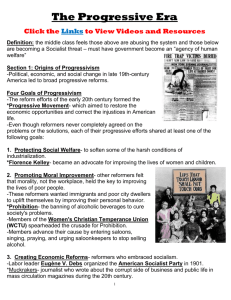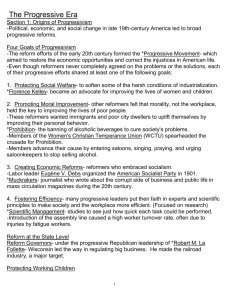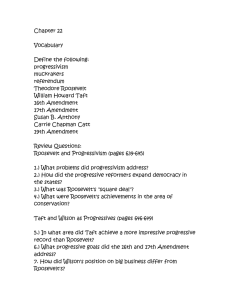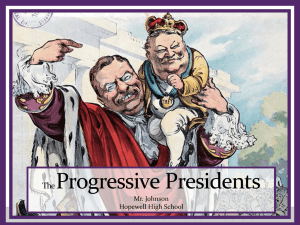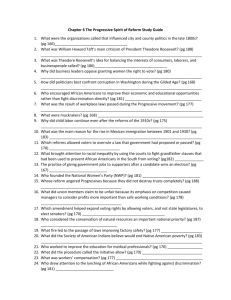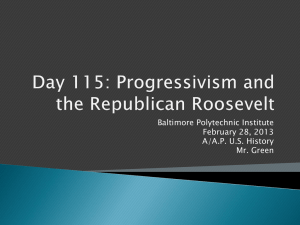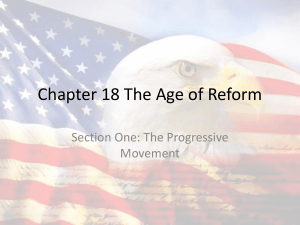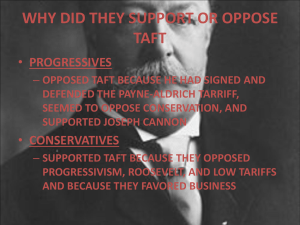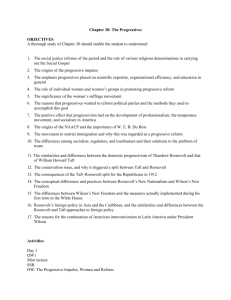Chapter 17: The Progressive Era - Montville Township School District
advertisement
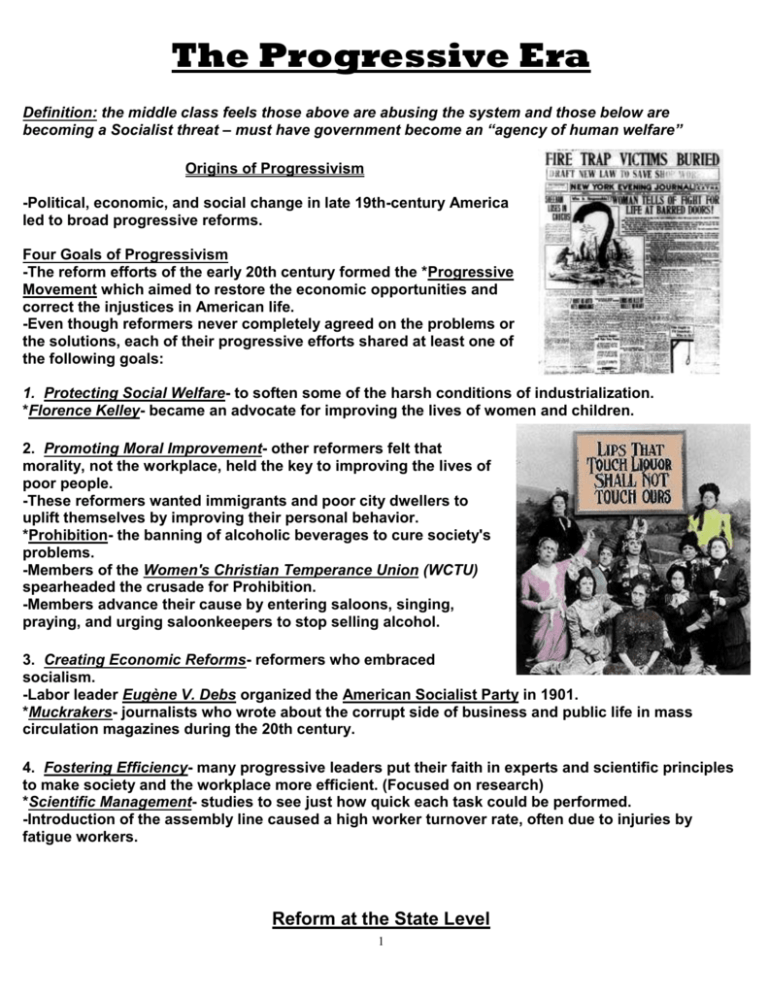
The Progressive Era Definition: the middle class feels those above are abusing the system and those below are becoming a Socialist threat – must have government become an “agency of human welfare” Origins of Progressivism -Political, economic, and social change in late 19th-century America led to broad progressive reforms. Four Goals of Progressivism -The reform efforts of the early 20th century formed the *Progressive Movement which aimed to restore the economic opportunities and correct the injustices in American life. -Even though reformers never completely agreed on the problems or the solutions, each of their progressive efforts shared at least one of the following goals: 1. Protecting Social Welfare- to soften some of the harsh conditions of industrialization. *Florence Kelley- became an advocate for improving the lives of women and children. 2. Promoting Moral Improvement- other reformers felt that morality, not the workplace, held the key to improving the lives of poor people. -These reformers wanted immigrants and poor city dwellers to uplift themselves by improving their personal behavior. *Prohibition- the banning of alcoholic beverages to cure society's problems. -Members of the Women's Christian Temperance Union (WCTU) spearheaded the crusade for Prohibition. -Members advance their cause by entering saloons, singing, praying, and urging saloonkeepers to stop selling alcohol. 3. Creating Economic Reforms- reformers who embraced socialism. -Labor leader Eugène V. Debs organized the American Socialist Party in 1901. *Muckrakers- journalists who wrote about the corrupt side of business and public life in mass circulation magazines during the 20th century. 4. Fostering Efficiency- many progressive leaders put their faith in experts and scientific principles to make society and the workplace more efficient. (Focused on research) *Scientific Management- studies to see just how quick each task could be performed. -Introduction of the assembly line caused a high worker turnover rate, often due to injuries by fatigue workers. Reform at the State Level 1 Reform Governors- under the progressive Republican leadership of *Robert M. La FolletteWisconsin led the way in regulating big business. He made the railroad industry, a major target. Protecting Working Children -As the number of children workers rose dramatically, reformers worked to protect workers and to end child labor. -Businesses hired children because they performed unskilled jobs for lower wages and because children's small hands made them more adapt to handling small parts and tools. -Formed in 1904, the National Child Labor Committee, sent investigators to gather evidence of children working in harsh conditions. They then organized exhibitions with photographs and statistics to dramatize the children's plight. -The Keating-Owen Act in 1916 prohibited the transportation across state lines of goods produced with children labor. Reforming Elections *Initiative- a bill originated by the people rather than lawmakers -- on the ballot. Then voters, instead of the legislature, accepted or rejected the initiative by *Referendum- a vote on the initiative. *Recall- enabled voters to remove public officials from elected positions by forcing them to face another election before the end of their term if enough voters asked for it. -By 1920, 20 states had adopted at least one of these procedures. *17th Amendment- 1913, direct election of senators. Before this, each states’ legislature chose its own US Senator. Women in Public Life -As a result of social and economic change, many women entered public life as workers and reformers. Women in the Workforce -Before the Civil War women were expected to devote their time to care for their homes and families. -By the 19th-century few women could afford to do so anymore. -Women took on more responsibilities on the farm, in the industries, with high school education, offices, stores, and classrooms. -Domestic work was popular among unskilled workers. (70% of all women employed in 1870 were servants) Women Lead Reform 2 -Dangerous conditions, low wages, and long hours led many female industrial workers to push for reforms. -Many women were able to attend college. Almost half of college educated women in the late 19th century, never married, retaining their own independence. *NACW- African-American women founded the National Association of Color Women in 1896, by merging to earlier organizations. *Susan B. Anthony- was a leading proponent of women's *Suffrage- the right to vote. -In 1869 Susan B. Anthony and *Elizabeth Cady Stanton- founded the *National Women Suffrage Association (NWSA), which united with another group in 1890 to become the *National American Women Suffrage Association (NAWSA). Teddy Roosevelt's Square Deal - As president, Theodore Roosevelt worked to give citizens a Square Deal through progressive reforms. *Upton Sinclair- a muckraking journalist who exposed the terrible conditions of the meatpacking industry in his 1906 book, The Jungle. -Roosevelt saw the presidency as a "bully pulpit", from which he could influence the news and media and shape legislation. -If big business victimized workers, then he would make sure that the common people received a *Square Deal- his program of progressive reforms designed to protect them from big businesses. 3 Using Federal Power Trust-busting- by 1900, trust -- legal bodies created to hold stock in many companies -- controlled about 4/5 of the industries in the US. -Many trusts lowered their prices to drive competitors out of the market and then took advantage of the lack of competition to jack up prices even higher. -Although Congress had passed the Sherman Antitrust Act in 1890, the act’s vague language made enforcement difficult. 1902 Coal Strike- when 140,000 coal miners in Pennsylvania, went on strike and demanded a 20% raise, a nine hour workday, and the right to organize a union, the mine operators refused to bargain. -Five months into the strike, coal reserves ran low. Roosevelt, seeing the need to intervene, called both sides to the White House to talk, and eventually settled the strike. -From then on, when a strike threatens the public welfare, the federal government was expected to intervene. Railroad Regulation -Roosevelt's real goal was federal regulation. -With Roosevelt urging, Congress passed the Elkins Act in 1903, which made it illegal for railroad officials to give, and shippers to receive, rebates for using particular railroads. -The act also specified that railroads could not charge set rates without notifying the public. -Hepburn Act of 1906- strictly limited the distribution of free RR passes, a common form of bribery. It also gave the ICC power to set maximum railroad rates. Health and the Environment -After reading The Jungle, Roosevelt pushed for the passage of the *Meat Inspection Act- which dictated strict cleanliness requirements for meat packers and created the program of federal meat inspection that was in use until it was replaced by more sophisticated techniques in the 1990s. *Pure Food and Drug Act- 1906 halted the sale of contaminated foods and medicines and called for truth in labeling. -Late 19th century-Americans had exploited their natural environment. -Forests were leveled, prairies were plowed, and cattle were allowed to overgraze the plains. -Coal companies cluttered the land, lumber companies neglected to replace trees, city dumped untreated sewage and industrial waste into rivers, poisoning the streams and creating health hazards. *Conservation- the protection of some wilderness areas and the development of others for the common good. 4 Roosevelt and Civil Rights -Like most other progressives- he failed to support the civil rights of AfricanAmericans, although, he did support of few individual African-Americans. -Roosevelt invited Booker T. Washington to the White House as a symbolic gesture. -Washington was respected by powerful whites, but faced opposition from other African-Americans such as W.E.B. Du Bois, for his accommodation of segregationists and for blaming black poverty on blacks and urging them to accept discrimination. -At a Niagara Falls convention in 1909, Du Bois and others founded the *NAACP- National Association for the Advancement of Colored People. -The NAACP, which had over 6,000 members by 1914, aimed for nothing less than full equality among the races FOREIGN POLICY The PANAMA CANAL- TR wanted to build a canal in Columbia now “Panama” to link the Oceans for American interests militarily and economically. Columbia refused America’s offer, so Roosevelt backed a Panamanian Revolution to overthrow the government. The canal was then permitted by the newly formed Panama government. BIG STICK Foreign Policy – America has the responsibility to civilize the rest of the world, to protect and police South America. America has a global responsibility. He developed this policy from the Monroe Doctrine to ensure no European country would interfere with South America. CLICK HERE Progressivism Under Taft (27th president) 5 Taft Becomes President *William Howard Taft- handpicked by Roosevelt to run for president in 1908 to run against William Jennings Bryan. -Taft had campaigned on a platform of lowering tariffs. *Payne-Aldrich Tariff-passed by Taft, was a set of tax regulations, enacted by Congress in 1909, that failed to significantly reduce tariffs on manufactured goods-it would increase many rates. -This angered progressives who believed that Taft had abandoned progressivism. *Progressive Movement- in early 20th-century reform movement seeking to return control of the government to the people, to restore economic opportunities, and to correct the injustices of American life. The Republican Party Splits -Taft's continuous actions made it impossible for him to hold together the two wings of the Republican Party. (The Progressives who sought change and the Conservatives who did not) -Problems within the Party would lead to mass defeat in 1912 and would help the Democrats gain control of the House of Representatives for the first time in 18 years. The Bull Moose Party- (another 3rd-party) led by Theodore Roosevelt. -The Progressive party became known as the *Bull Moose Party- old Republican progressives. CLICK HERE -Platform: called for direct election of senators and adoption in all states of the initiative, referendum, and the recall. -Also advocated women's suffrage, workmen's compensation, the 8 hour workday, a minimum wage for women, a federal law against child labor, and the federal trade commission to regulate businesses. Democrats Win in 1912 *Woodrow Wilson- a Democrat reformer and governor of New Jersey. -He endorsed a progressive platform, called the New Freedom, which demanded even stronger antitrust legislation, banking reform, and reduced tariffs. -Although Wilson captured only 42% of the popular vote, he won an overwhelming electoral victory and a Democratic majority in Congress. 6 Wilson's New Freedom -Wilson established a strong reform agenda as a progressive leader. Wilson Wins Financial Reforms Two Key Antitrust Measures *Trust- a corporation made up of many companies that receive certificates entitling them to dividends on profits earned. *Clayton Antitrust Act- 1914 sought to strengthen the Sherman Antitrust Act of 1890. -Intended to prevent the creation of monopolies by making it illegal to establish trusts that interfered with free trade. -It prohibited corporations from acquiring the stock of another if doing so would create a monopoly. *The Federal Trade Commission Act of 1914- set up the Federal Trade Commission (FTC) -This “watchdog” agency was given the power to investigate possible violations of regulatory statutes, to require periodic reports from corporations, and to put an end to a number of unfair business practices. Federal Income Tax *16th Amendment- 1913 legalized a graduated income tax, which provided revenue by taxing individual earnings and corporate profits. Federal Reserve System *The Federal Reserve Act of 1913- divided the nation into 12 districts and established a regional central bank in each of them. *Carrie Chapman Catt- NAWSA's president and successor to Susan B. Anthony, organized the Women's Suffrage Party, which concentrated on five tactics: 1. Painstaking organization 2. Close ties between local, state and national workers. 3. Established a wide base of support. 4. Continuous lobbying. 5. Gracious, ladylike behavior. *18th Amendment- 1919 Prohibited the making, selling or transportation of alcohol. CLICK HERE *19th Amendment- 1920 granting women the right to vote. 72 years after women had first convened and demanded the vote at the Seneca Falls convention in 1848. 7 The Limits of Progressivism -Like Roosevelt and Taft, Wilson retreated on civil rights once in office. -Wilson agreed to do African-Americans justice… and he felt that separate but equal was justice enough. -International conflict was destined to be part of Wilson's presidency. -During the early years of his administration, Wilson had dealt with issues of imperialism that had roots in the 19th century. -However, World War I dominated most of his second term as president. -The progressive era had come to an end. 8

